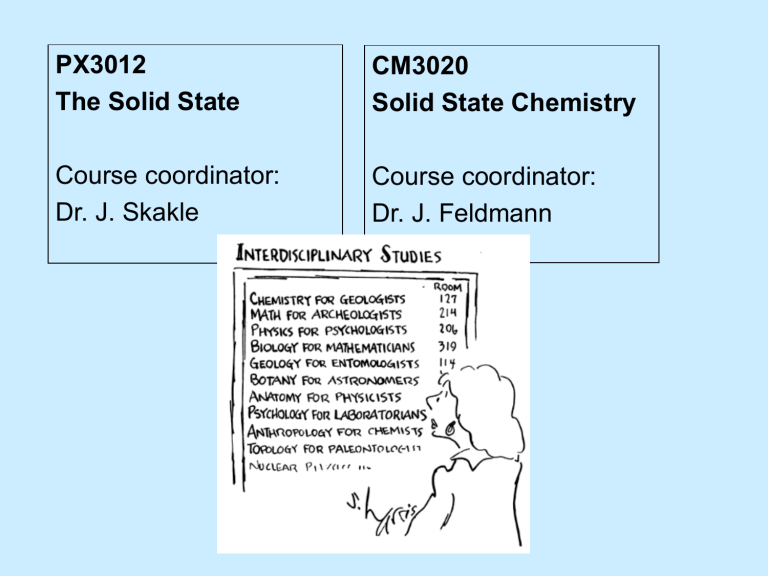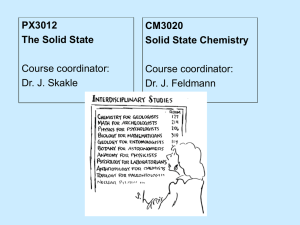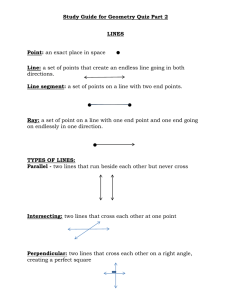
PX3012
The Solid State
CM3020
Solid State Chemistry
Course coordinator:
Dr. J. Skakle
Course coordinator:
Dr. J. Feldmann
SOLID STATE
Crystals
Crystal structure basics
unit cells
symmetry
lattices
Diffraction
how and why - derivation
Some important crystal structures and properties
close packed structures
octahedral and tetrahedral holes
basic structures
ferroelectricity
Objectives
By the end of this section you should:
• be able to identify a unit cell in a symmetrical
pattern
• know that there are 7 possible unit cell shapes
• be able to define cubic, tetragonal,
orthorhombic and hexagonal unit cell shapes
Why Solids?
most elements solid at room temperature
atoms in ~fixed position
“simple” case - crystalline solid
Crystal Structure
Why study crystal structures?
description of solid
comparison with other similar materials classification
correlation with physical properties
Crystals are everywhere!
More crystals
Early ideas
• Crystals are solid - but solids are not
necessarily crystalline
• Crystals have symmetry (Kepler) and long
range order
• Spheres and small shapes can be packed to
produces regular shapes (Hooke, Hauy)
?
Group discussion
Kepler wondered why snowflakes have 6 corners,
never 5 or 7. By considering the packing of
polygons in 2 dimensions, demonstrate why
pentagons and heptagons shouldn’t occur.
Definitions
1. The unit cell
“The smallest repeat unit of a crystal structure, in 3D,
which shows the full symmetry of the structure”
The unit cell is a
box with:
• 3 sides - a, b, c
• 3 angles - , ,
Seven unit cell shapes
•
•
•
•
•
•
•
Cubic
Tetragonal
Orthorhombic
Monoclinic
Triclinic
Hexagonal
Rhombohedral
a=b=c
a=bc
abc
abc
abc
a=bc
a=b=c
===90°
===90°
===90°
==90°, 90°
90°
==90°, =120°
==90°
Think about the shapes that these define - look at the
models provided.
2D example - rocksalt
(sodium chloride, NaCl)
We define lattice points ; these are points
with identical environments
Choice of origin is arbitrary - lattice points need not be
atoms - but unit cell size should always be the same.
This is also a unit cell it doesn’t matter if you start from Na or Cl
- or if you don’t start from an atom
This is NOT a unit cell even though they are all the
same - empty space is not allowed!
In 2D, this IS a unit cell
In 3D, it is NOT
All M.C. Escher works (c) Cordon Art-Baarn-the Netherlands.
All rights reserved.
Examples
The sheets at the end of handout 1 show examples of
periodic patterns. On each, mark on a unit cell.
[remembering that there are a number of different
(correct) answers!]
Summary
Unit cells must link up - cannot have gaps
between adjacent cells
All unit cells must be identical
Unit cells must show the full symmetry of
the structure next section



